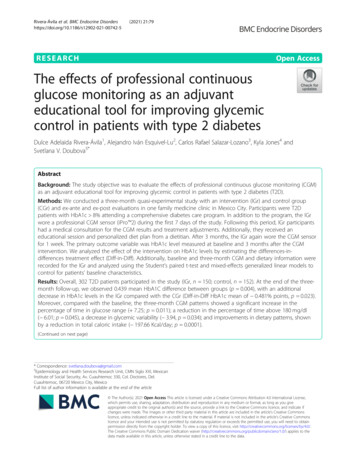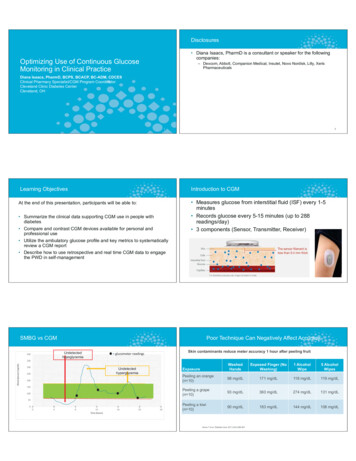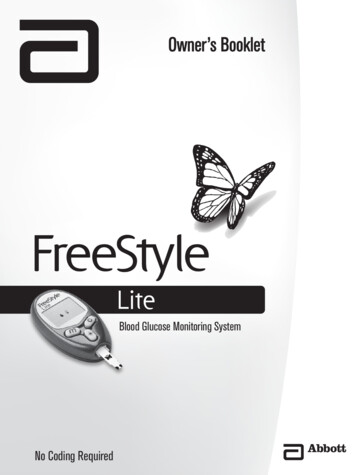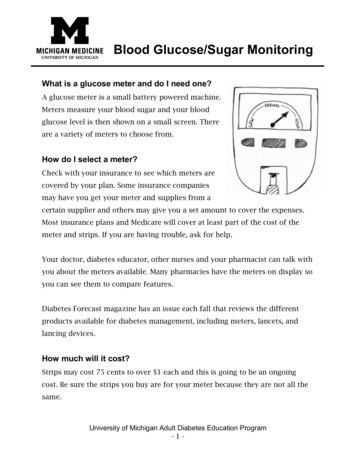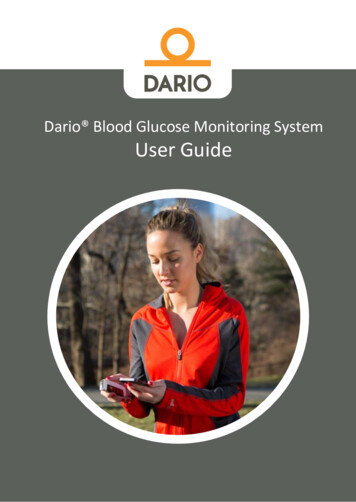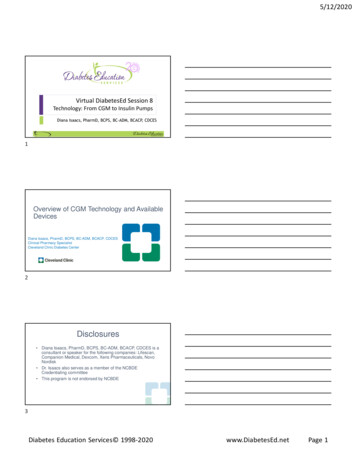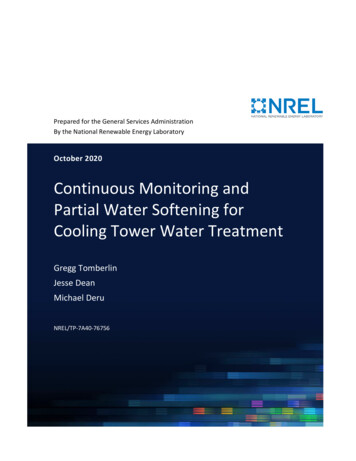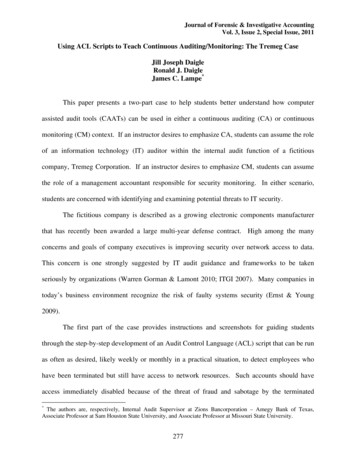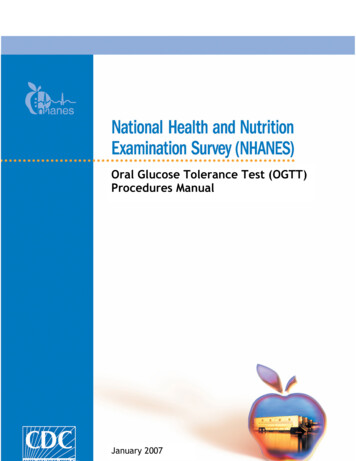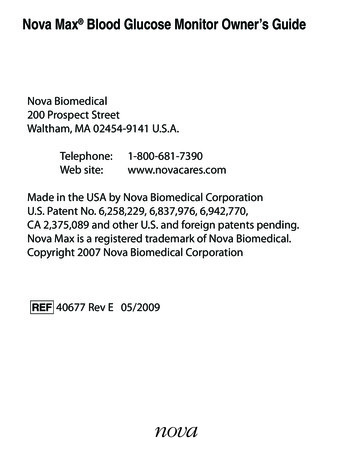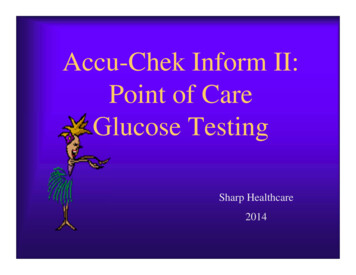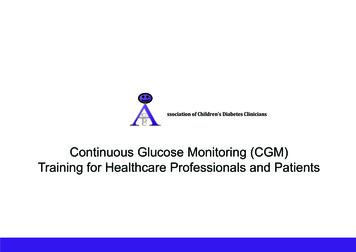
Transcription
nsContinuous Glucose Monitoring (CGM)Training for Healthcare Professionals and Patients1
nsChapterContentsPage no.ChapterPage no.STEP 1 .3STEP 3 .24Getting started with CGM system - Dexcom G5 . 4Recap the target glucose range and trend arrows .26Difference between blood glucose and interstitialglucose readings . .9Insulin adjustment tools .27How to use the total dose percentage adjustment tool .28Learn to identify trends and patterns .11How to use the insulin sensitivity factor tool (ISF) .32What to practise for STEP 2 .14Correction dose adjustment .35STEP 2 . .15Trend arrows and low glucose levels .36Setting alerts for high and low glucose readings .17What to practise for STEP 4 .37HbA1c and targets .18STEP 4 .38Setting glucose alerts .19Recap the target glucose range .39Using trend arrows to set advanced alerts . 21How to use the Ambulatory Glucose Profile (AGP), Diasendand trend data .41What to practise for STEP 3 . 23Summary.4922
nsDexcom G5Glucose Monitoring SystemPatient leafletSTEP 1 You must attend the first 4 training sessions to ensure you know how to use the Dexcom G5There are 4 leaflets to remind you of the 4 step trainingYou will be asked to write down your reasons for using the CGM and what your targets areFurther training will be arranged following completion of these first 4 stepsAs you get older the way you look after your diabetes will need changingOngoing education is an essential part of your diabetes care to make sure you reach yourtargets33
nsDexcom G5 - Introduction - Patient informationAims for STEP 1: Getting started withyour Dexcom G5Getting started with CGM system - Dexcom G5Difference between blood glucose and interstitial glucose readingsLearn to identify trends and patternsWhat to practise for STEP 2Aims for STEP 2: Setting alerts for high and low glucose readingsHbA1c and targetsUsing trend arrows to set advanced alertsWhat to practise for STEP 2Aims for STEP 3: Recap the target glucose range and trend arrowsInsulin adjustment toolsHow to use the total dose percentage adjustment toolHow to use the insulin sensitivity factor tool (ISF)Correction dose adjustmentTrend arrows and low glucose levelsWhat to practise for STEP 3Aims for STEP 4: Recap the target glucose rangeUsing AGP profile, Diasend and trend dataSummary44
nsDexcom G5 - Introduction - Patient informationGetting started with your Dexcom G5Aims for using Dexcom G5What are your reasons for using the Dexcom G5?Tick the statement/s below that you agree with.What are your aims for using the Dexcom G5?Discuss these with your educator and make a note below:Suggestions for using the CGMTickAims for using the CGMPrevent hypos (low blood glucose levels)Prevent high blood glucose levelsManage blood glucose better when playing sportLess blood testing from the fingersWould like more information about blood glucoselevelsAny other reasons? Write belowRemember!Look out for this symbol to remind you of the mainmessages in each step55
nsDexcom G5 - STEP 1 - Patient informationAUnderstanding the Dexcom G5 equipmentABDCBDCEE6This is the sensor which measures the glucose levelin the tissues. See page 9 for more details. It may be wornfor 7 days before it needs replacing.This is the transmitter which collects the messages from thesensor and sends it to the receiver and or smart device.It can be used for 3 months before it needs replacing (usingthe wireless feature to a smart phone uses more battery).The transmitter and receiver need to be within 6 metres ofeach other to see glucose level. It does not store glucoselevels if out of range for any period of time.The receiver accepts the glucose level results and displaysthe information over a set time period. It will also storeglucose results ready to download. It needs charging every3 days with a micro USB. To use the receiver is optional asyou may use your smart device.This is a smart device (Android or iphone) so that you canview your glucose profile from the Dexcom G5 app.Dexcom app symbol. This app needs to be downloaded tolook at CGM data on a smart device. Up to 5 people mayshare this information.6
nsDexcom G5 - STEP 1 - Patient informationUnderstanding the Dexcom G5 receiverscreenWirelesssymbol3 hour trend graphThe 3 hour trend graph will be displayed automatically but it may bechanged to 1, 6, 12, 24 hour display.Yellow and red linesCurrent glucose levelBatterylifeThe yellow and red lines show your alert settings (to be discussedin step 2)The receiver is programmed with an urgent low alarm set at 3.1mmol/L. First warning is 4 vibrations followed by 4 beeps every 5mins until you confirm it by pressing the select button.Glucose trend arrowGlucose valuesGlucose trend.Each dot is a glucose readingtaken every 5 minsYellow line is upperglucose target leveland alertGlucose target rangeGlucose target rangeThis is the area between your upper and lower target range. Thiswill be set up in STEP 2Red line is lowerglucose target leveland alertBattery lifeThe battery will last for approximately 6 months then it will needreplacing3 hour trendWireless symbolThe wireless symbol is displayed when the transmitter and receiverare connectedCurrent glucose levelThis is the glucose level in the tissues over the past 5 mins77
nsDexcom G5 - STEP 1 - Patient informationGetting started with your Dexcom G5During your first 2 weeks you must also:You will be shown how to apply your sensor and what the information onthe meter screen means.Download your data at least once a week into your home DexcomCLARITY or Diasend (clinic use only) and bring a print out to STEP2 training session. Start to think about how you need to assess yourglucose control.For the first 2 weeks you will be asked to simply watch the display to seehow the reader records your glucose and the use of the arrows.Check a blood glucose:You must keep using your blood glucose meter until you attend thesecond training session (STEP 2). Keep a record of: To confirm a low (less than 4.0 mmol/L) or high (14.0 mmol/L)sensor glucose reading. Glucose level before and 2 hours after a meal Glucose during illness or stress If Glucose levels are falling rapidly The effect of physical activity on your glucose reading If CGM readings do not match your clinical symptoms What your arrow trend is overnight The effect of meal insulin doses The timing of your meal time insulin in relation to the time of yourmeal or snack i.e. 5, 10, 15 mins before your meal or rising rapidly ##Remember!Your sensor will need changing in 7 daysThe receiver needs charging every 3 daysWhat is the effect of your hypo treatment on your glucose. Do youunder correct or over correct?Each new sensor will need calibrating twice a dayFor 2 hours after calibration blood glucose tests are used for insulindose adjustment (ONLY after completing STEP 2)Record the start date and expiry date of your sensor:Start dateRecord glucose levels from your CGM alongside your usual bloodglucoseChange dateDo not alter insulin doses using your CGM until STEP 2 iscompleted88
nsDexcom G5 - STEP 1 - Introduction - Patient informationWhy is checking the glucose levelsimportant?What is the difference between blood glucosemonitoring and interstitial glucose readingsCGM?Researchers in America have proven that keeping glucose levelsin single figures most of the time reduces the chance, for somepeople, of getting problems with the eyes, kidneys, nerves andblood vessels.This is why there are many different devices available to helpchildren, young people and adults monitor their glucose levels.However simply recording glucose levels is not enough. Anyobvious patterns showing a need to change insulin treatment orrevision of carbohydrate counting needs to be acted upon.Continuous education is essentialThere are 2 types of meter that read glucose levels but in adifferent way:1. Blood glucose meter2. Interstitial glucose meter or continuous glucose monitoringsystem (CGM) Blood glucose (BG) monitoring is taken using a finger pricker andmeter. This gives the glucose value at the moment it is taken Interstitial glucose (CGM) monitoring. This measures the glucosebetween the tissues via an indwelling sensor There is a time delay between the true blood glucose level andthe glucose level in the tissues using CGM This is called the lag time. (See page 10). It means the glucoselevel in the tissues will always be 6-12 mins behind the trueglucose level There are different symbols called trend arrows on the CGMto help you to decide how to interpret the results this will bediscussed in STEP 2Remember!Choosing to use the CGM means a new way of glucose monitoringrstand what theIt is important to undeto interpret thedifference is and howTrend arrows help in the decision makingTraining is essential to interpret the increased number of glucosereadingsresults99
nsDexcom G5 Lag time - STEP 1 - Patient informationThe lag time is the difference in measurement between the actual blood sugar level and the interstitial glucose level.The time difference can vary between 6-12 minsIf your values are falling rapidly, your blood glucose value might initially be lower than the sensor reading(see diagram)If the values are rising rapidly the blood glucose value might be higher than the sensor reading but then the sensor reading will go higher thanyour blood glucose value ' (see diagram below)''' 10Lag time10
nsDexcom G5 Trend arrows - STEP 1 - Patient informationWhat the trend arrows mean on yourDexcom G5What the trend graphs mean on yourDexcom G5The trend arrow shows (circled in red): If the glucose is stable, rising orfalling How fast this change is happeningArrowTrendDescription of trend arrowThe trend graph is a time frame for your to look at your glucoselevels in more detail. Stable: Glucose is fairly stable. It may go up or down by0.8 mmol/L in 15 minsSlowly rising: Glucose is rising slowly.It may go up by 1.7 mmol/L in 15 minsRising: Glucose is going up.It could go up by 2.5 mmol/L in 15 minsRising rapidly: Glucose is going up quickly.It may go up more than 2.5 mmol/L in 15 minsSlowly falling: Glucose is going down slowly.It may go down by 1.7 mmol/L in 15 minsFalling rapidly: Glucose is going downIt could fall by 2.5 mmol/L in 15 minsFalling very rapidly: Glucose is going down very quick.It could go down by more than 2.5 mmol/LBlankIf no trend arrow appears: The receiver cannot work outNo arrow if the glucose is going up or down and how fastIt can be set at 1, 6, 12 or 24 hour intervals (3 hour is alwaysdisplayed when the receiver is switched on).You can switch between these times if you need to. Over the next 2 weeks you will be asked to look at the different trendgraphs and work out which one you prefer.Think about why you want to use the CGM and which method oflooking at your glucose levels is better for you. But do not use the glucose results for altering your insulin dose untilyou have completed STEP 2 and 3.1111
nsDexcom G5 Trend graphs - STEP 1 - Patient information12 hour trend3 hour trendGood to use for: Checking overnight glucoselevels Looking at the glucose levelduring the nightThis appears when the receiveris turned onGood to use for: Mealtimes and after During exercise A daily trend1 hour trend24 hour trendGood to use for: Times when you have madechanges to insulin or treateda hypo Showing a change in glucosedirection quicker than thetrend arrowsGood to use for: Looking at the whole day Checking for any highs or lowsduring the day Comparing with other days tosee for patterns when glucoseis out of target range6 hour trendGood to use for: Checking your basal or background insulin dose Checking the effect of insulinon meals containing largeamounts of fat Checking effects of exerciseRemember!The trend graphs can help you pick out any times your glucose levelis out of range.They can give you a quicker idea about how quickly the glucose ischanging1212
nsDexcom G5 - STEP 1 - Patient informationGeneral information Check the adhesive patch is firmly in place before going inwater. More plaster may be added but not over the sensor Review data by downloading once a week Sensor needs to be changed every 7 days Change position of sensor to prevent problems with the sensorsite To get the benefit from CGM, You must wear it at least 70%of the time Sensor worn around the abdomen but 8cm away from pump orinjection site or outer part of the buttocks You must check a blood glucose to confirm a low or highsensor glucose reading The transmitter may be used for up to 3 - 6 months (due to thewireless linking with smart phones) Extra information on insulin dose, exercise, food intake may beset in Notes on the CGM Calibration is needed for every sensor change and every 12hours to ensure accuracy The first reading may be taken 2 hours after changing the sensor Do not use any alerts for the first 2 weeks (to be discussedfurther in STEP 2) Download App onto smart device to view readings Make sure smart device is turned on You may set an alert for a low glucose for first 2 weeks Keep smart device charged to receive information Sensor ONLY is water resistant up to 2.4 metres for up to 24hoursWARNING!upe glucose readings forthctsfeaflyusrioseolParacetamse.to 6 hours after last doracetamoladings when taking paDo not use Dexcom reRemember!It must be worn at least 70% of the timeDownload data once a week to review glucose controlParacetamol affects glucose readings1313
nsDexcom G5 - STEP 1 - Patient informationWhat to practise for next session - STEP 2Date for STEP 2 training:For the first 2 weeks watch the display to see how the CGM readerrecords your glucose and observe the direction of trend arrows anduse the trend graphs.Diabetes team contact details:You must keep using your blood glucose meter until you attendthe second training session (STEP 2). Keep a record of: Glucose level before and 2 hours after a meal Glucose during illness or stress The effect of physical activity on your glucose reading What your trend arrow is doing overnight The effect of meal insulin doses on your glucose level Note what time you take your insulin and what time you eat yourmeal or snackNotes:Remember!You must also: Read the receiver within 10 mins if the trend arrow is pointingstraight up or down Download your data at least once a week and bring to the STEP2 training session Think about how you will use the CGM glucose readings Check a blood glucose to confirm a low (4.0 mmol/L) or high(14.0 mmol/L) sensor glucose reading or if glucose levels arefalling rapidly or rising##Do not use your Dexcom for changes to your insulin doses untilyou have completed STEP 2At your next session your blood glucose results and CGM results willbe discussedAfter STEP 2 training you will start to use your CGM readings fortreatment changesPARACETAMOL affects the sensor so will give false glucosereadingsrapidly1414
nsDexcom G5Glucose Monitoring SystemPatient leafletSTEP 2 You must attend the first 4 training sessions to ensure you know how to use the Dexcom G5There are 4 leaflets to remind you of the 4 step trainingYou will be asked to write down your reasons for using the CGM and what your targets areFurther training will be arranged following completion of these first 4 stepsAs you get older the way you look after your diabetes will need changingOngoing education is an essential part of your diabetes care to make sure you reach yourtargets1515
nsDexcom G5 - Introduction - Patient informationAims for STEP 1: Getting started withyour Dexcom G5Getting started with CGM system - Dexcom G5Difference between blood glucose and interstitial glucose readingsLearn to identify trends and patternsWhat to practise for STEP 2Aims for STEP 2: Setting alerts for high and low glucose readingsHbA1c and targetsUsing trend arrows to set advanced alertsWhat to practise for STEP 2Aims for STEP 3: Recap the target glucose range and trend arrowsInsulin adjustment toolsHow to use the total dose percentage adjustment toolHow to use the insulin sensitivity factor tool (ISF)Correction dose adjustmentTrend arrows and low glucose levelsWhat to practise for STEP 3Aims for STEP 4: Recap the target glucose rangeUsing AGP profile, Diasend and trend dataSummary1616
nsDexcom G5 - STEP 2 - Alert settings - Patient information2. Prevent low glucose levelsSetting alerts for high and low glucosereadingsIf your reason for using the CGM is to prevent hypos or you are notsure of your hypo signs and symptoms then try setting the low alerthigher than 4 mmol/L. I.e. 5.5 mmol/L.This way you will be aware your glucose is falling and prevent ahypo from happening.Your glucose target range is set to make sure you know what thebest glucose level to aim for is.The alerts are your warning signs that your glucose control is notwithin this ideal target range.It may take time to achieve glucose levels within your target rangemost of the time but the alerts can be set so that you graduallyimprove your glucose levels without having too many high or lowevents.Remember!If worried about hypos during the nightyou can start by setting your low alertat 5 mmol/LRegularly checking your receiver means you are not relying on thealerts to manage your glucose levels. This means you can set youralerts higher or lower.The alerts and trend arrows (how fast your glucose is falling) willgive you the information you need to pick up on any patterns aboutwhen you go low and hopefully help you to start to recognise yoursigns and symptoms.Reasons for using the CGM:1. Prevent high glucose levels3. Urgent low alarm cannot be changed or switched offThere is an alarm that will sound when the sensor reading is3.1 mmol/L or lower. It will protect you from very low glucose levels.If your goal is to prevent a high glucose but are unsure of the CGMthen start by setting the high alert higher than you would want to.Remember!To decide how high look at your blood glucose results over the past2 weeks and work out with your diabetes educator an upper alert.The glucose level in your blood fallsbefore the glucose
This is a smart device (Android or iphone) so that you can view your glucose profile from the Dexcom G5 app. E. Dexcom app symbol. This app needs to be downloaded to . Download your data at least once a week into your home Dexcom CLARITY or Diasend (clinic use only) and bring a print out

